Pett Emergency Coast Defence Battery (2)
Posted: 22 February 2008 23:08
Back in October 2006, I described a visit to Pett Emergency Coast Defence Battery, a large part of which still remains comparitively intact, although derelict.
Today I made a return visit with the intention of measuring up the gun position so that I could model it in 3D using Google Sketchup.
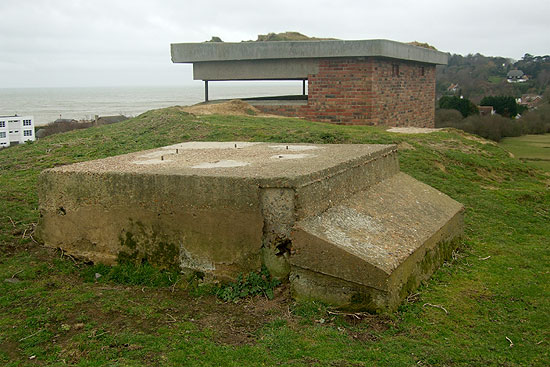
There are three distinct areas of the battery publicly accessible up on Toot Rock; on the west end of the high ground are a Bofors anti-aircraft gun position, the brick Battery Observation Post (BOP) and a concrete holdfast (both seen in the photo above). A short distance down the slope to the north is a spigot mortar pedestal, but the area I was most interested in today was the No.1 (western) gun emplacement.
The basic diagram I drew following my previous visit is shown below:

A helpful aid to conducting a survey of a site on a subsequent visit is to plan the various measurements I need to take using the data and photographs of the initial visit. I expanded the diagram above to produce that seen below.
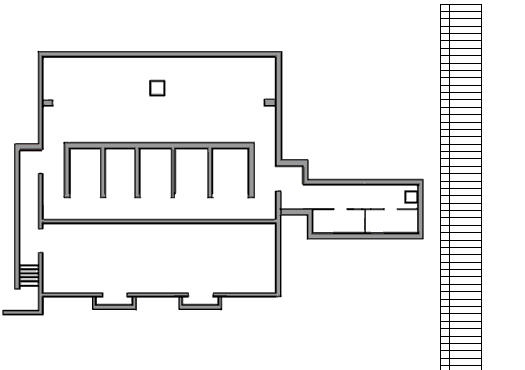
Having printed it out, I drew on a series of lines describing the vital statistics I would need and numbered them. The table was then numbered correspondingly in the left column, with the actual measurements being recorded in the right column. This simple expedient makes life very much simpler when you're out in the field, freezing cold, getting fed up and in danger of being blown off a cliff whilst struggling to hold onto your soggy paperwork.
Proper planning in this respect means you can easily identify which dimensions you need to measure without having to draw rough sketches on the spot with messy, inky scrawlings that you can't interpret once you get home. I also print out key photographs to draw dimensions (particularly vertical measurements) on. The 'finished' plan is seen below.
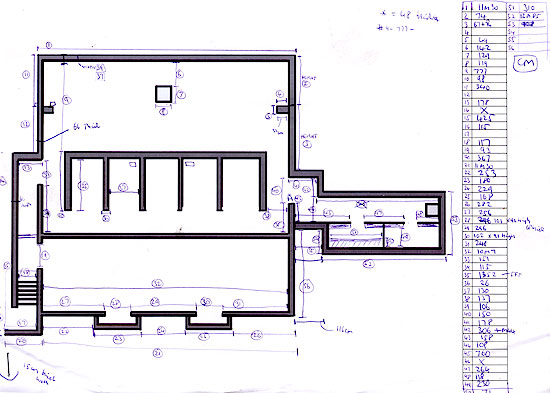
The benefits of such planning are seen below; this is my 3D model of the gun emplacement so far, seen from the rear. It should be remembered that the emplacement is dug into a hillside and that the roofs are just at about ground level.
At right are the two storerooms (presumably for combustible materials) with the ground level escape/entry hatch. An open passageway leads into the gun position proper.
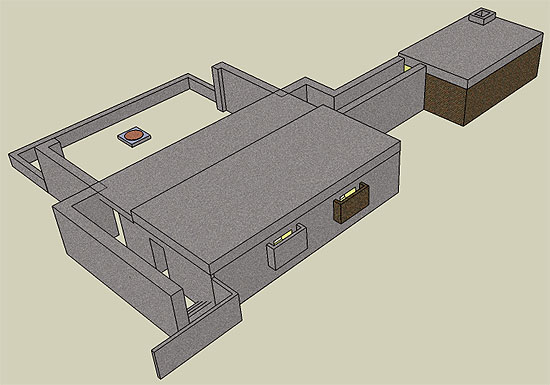
The image below shows the roofs removed; the five recesses in the magazine are situated between the gun floor and the war shelter.

A close-up of the gun floor, magazine and war shelter; the yellow colour is based on traces of paintwork still evident on the walls.
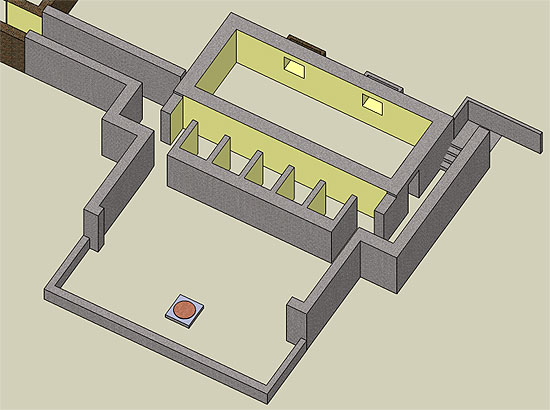
Below is a close-up of the storerooms; note the built-in concrete shelf and ladder leading to the hatch in the roof.
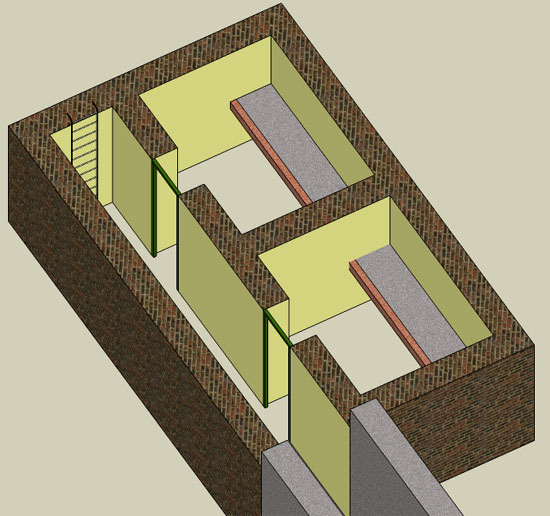
At right is a short video giving a tour of the gun position.
The tour first flies you around the exterior, first with the roof on, then without, allowing the internal arrangement to be viewed.
We then take a walk-through tour of the gun position, entering via the steps, moving into the war shelter, through the magazine, out onto the gun floor, along the passage to the storerooms (looking briefly into one) and then up the ladder to the hatch.
The 3D model is not finished; of the features that still survive, I have not yet drawn the vertical girders that used to prop up the roof over the gun floor. The roof itself has long gone, but I will eventually add it, and hopefully will find enough information to be able to draw the gun itself.
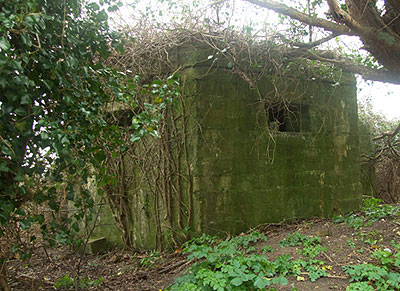
During my visit I also managed to measure up the BOP and holdfast, although I ran out of time and didn't get the chance to look closely at the Bofors position or spigot mortar pedestal.
However, a local resident very kindly showed me some other remnants of the battery on private property, as well as this Type 22 pillbox that stands on the north bank of the Royal Military Canal at what was the main vehicular access to the battery.
I will eventually add the other main features of the battery to my 3D model, but I will need to make another trip out to Pett to get some more data.
- Pete

Email:
Blog Latest

Bishopstone reveals its pillbox secrets
18 October 2021

Pillbox or Observation Post?
10 June 2020

Uncovering the hidden secrets of a pillbox
8 June 2019

Review of 2018
31 December 2018

Wartime Christmas in East Sussex (2)
24 December 2018
Jargon-buster
Battery Observation Post
A fire control centre for a gun battery, the term is usually synonymous with Emergency Coast Defence batteries. A BOP might be purpose-built or be established in an existing building, such as a Martello Tower. The BOP usually housed a range-finder as well as a Dumaresq fire control computer.
Emergency Coast Defence battery
As the name suggests, a battery established during wartime for coast defence to augment batteries established in peacetime. Emergency batteries established during 1940-41 usually employed a pair of old naval guns, usually either of 6-inch, 5.5-inch or 4-inch calibre.
Pillbox
Generic term for a hardened field defensive structure usually constructed from concrete and/or masonry. Pillboxes were built in numerous types and variants depending on location and role.

Type 22 pillbox
A small hexagonal pillbox for six men not commonly seen in East Sussex, though a few still survive along the Royal Military Canal stop line.
War shelter
Protective shelter in which a coast artillery gun crew are stationed ready for the call to action, hence its close proximity to the gun emplacement.
This site is copyright © Peter Hibbs 2006 - 2024. All rights reserved.
Hibbs, Peter Pett Emergency Coast Defence Battery (2) (2024) Available at: http://www.pillbox.org.uk/blog/216544/ Accessed: 16 April 2024
The information on this website is intended solely to describe the ongoing research activity of The Defence of East Sussex Project; it is not comprehensive or properly presented. It is therefore NOT suitable as a basis for producing derivative works or surveys!